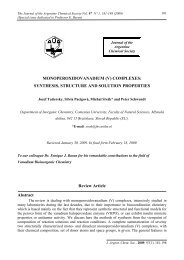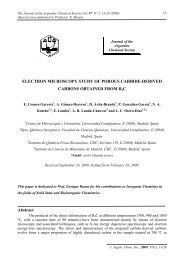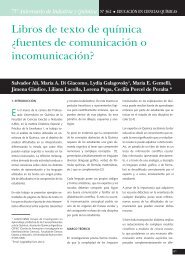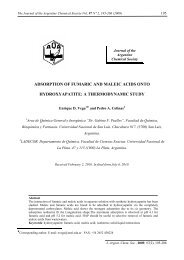Determination of ergosterol in cellular fungi by HPLC - Asociación ...
Determination of ergosterol in cellular fungi by HPLC - Asociación ...
Determination of ergosterol in cellular fungi by HPLC - Asociación ...
You also want an ePaper? Increase the reach of your titles
YUMPU automatically turns print PDFs into web optimized ePapers that Google loves.
<strong>Determ<strong>in</strong>ation</strong> <strong>of</strong> <strong>ergosterol</strong> <strong>in</strong> <strong>cellular</strong> <strong>fungi</strong> <strong>by</strong> <strong>HPLC</strong>… 12<br />
<strong>ergosterol</strong>, so we added from the beg<strong>in</strong>n<strong>in</strong>g <strong>of</strong> the technic an antioxidant such as BHT thus avoid<strong>in</strong>g<br />
the use <strong>of</strong> nitrogen.<br />
The basic procedures <strong>in</strong>volve sample extraction, saponification, partition<strong>in</strong>g, purification,<br />
determ<strong>in</strong>ation and quantification <strong>of</strong> <strong>ergosterol</strong>.<br />
Material and Methods<br />
We collected different samples <strong>of</strong> wet soil from San Luis (Potrero de los Funes and<br />
Quebrada de la Bolsa), Argent<strong>in</strong>a, with vegetation cover <strong>of</strong> ferns (Bryopteris sp., Cheilantes sp.,<br />
and Anemia sp.). The samples (2 g <strong>of</strong> each; with 24% humidity) were saponificated with 2g KOH<br />
<strong>in</strong> 25 mL <strong>of</strong> methanol (<strong>HPLC</strong> grade), <strong>in</strong> the presence <strong>of</strong> 100 µL <strong>of</strong> corticosterone (loss marker) and<br />
100 µL <strong>of</strong> butylated hydroxytoluene (BHT) as antioxidant. After the saponification (1 h reflux to<br />
70°C), they were left to cool. The supernatant was placed <strong>in</strong> a funnel and 20 mL <strong>of</strong> methanol was<br />
added twice over the precipitate. We jo<strong>in</strong>ed the three aliquots <strong>in</strong> the funnel with 30 mL <strong>of</strong> dry nhexane<br />
(previously filtered the 60mL <strong>of</strong> methanol though Millex-HV 0.45 µm- Millipore S.A.,<br />
Molsheim, France). This extraction was repeated twice. Fractions were jo<strong>in</strong>ed and taken to dryness<br />
<strong>in</strong> a Rotavapor. The samples were stored (4°C <strong>in</strong> darkness) until <strong>HPLC</strong> analysis. Each sample was<br />
re-dissolved <strong>in</strong> 200 µL methanol. For <strong>HPLC</strong> analysis we used a P100 isocratic pump (Spectra<br />
Physics), a UV-100 detector (Spectra Physics) and a Data Jet <strong>in</strong>tegrator (Spectra Physics), a flow<br />
rate <strong>of</strong> 1.0 mL/m<strong>in</strong>. The wavelength was set at 290 nm for determ<strong>in</strong>ate <strong>ergosterol</strong> and 254nm for<br />
corticosterone. Thus, each sample was <strong>in</strong>jected twice <strong>in</strong> the <strong>HPLC</strong>. The column used was a<br />
Supelcosil LC18 (Supelco; 5 µm, 250 x 4.6 mm).<br />
Methanol:acetonitrile, 80:20 v/v (<strong>HPLC</strong>-grade) was the mobile phase. Under these conditions the<br />
retention time was 13.4±0.2 m<strong>in</strong>. (Figure 1).<br />
13.4 m<strong>in</strong><br />
Figure 1. Ergosterol pr<strong>of</strong>ile isolated from <strong>cellular</strong> <strong>fungi</strong>.<br />
Spectra Physics <strong>HPLC</strong> equipment was used with an<br />
isocratic Pump P100 <strong>in</strong>corporated. The absorbance<br />
spectrum was plotted at 290nm with a UV 100 Spectra<br />
Physics detector, chart speed was 0.5 cm.m<strong>in</strong> -1 <strong>in</strong>tegrated<br />
with a Spectra Physics Data Jet Integrator. A Rheodyne<br />
<strong>in</strong>jector supplied with a 20μL loop was used. The column<br />
used was a Supelcosil C18 (Supelco; 5 µm, 250 x 4.6<br />
mm) and, as mobile phase, <strong>HPLC</strong>-grade methanol :<br />
acetonitrile (80:20 v/v). The retention time <strong>in</strong> these<br />
conditions was 13.4 m<strong>in</strong> ± 0.2 m<strong>in</strong> at a flow rate <strong>of</strong> 1.0<br />
mL.m<strong>in</strong> -1 and an attenuation <strong>of</strong> 128. A similar pr<strong>of</strong>ile was<br />
obta<strong>in</strong>ed for the steroid used to calculate the losses but,<br />
<strong>in</strong> this case the absorbance spectrum was plotted at<br />
254nm.






